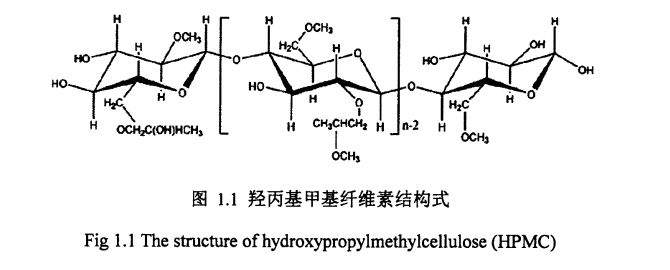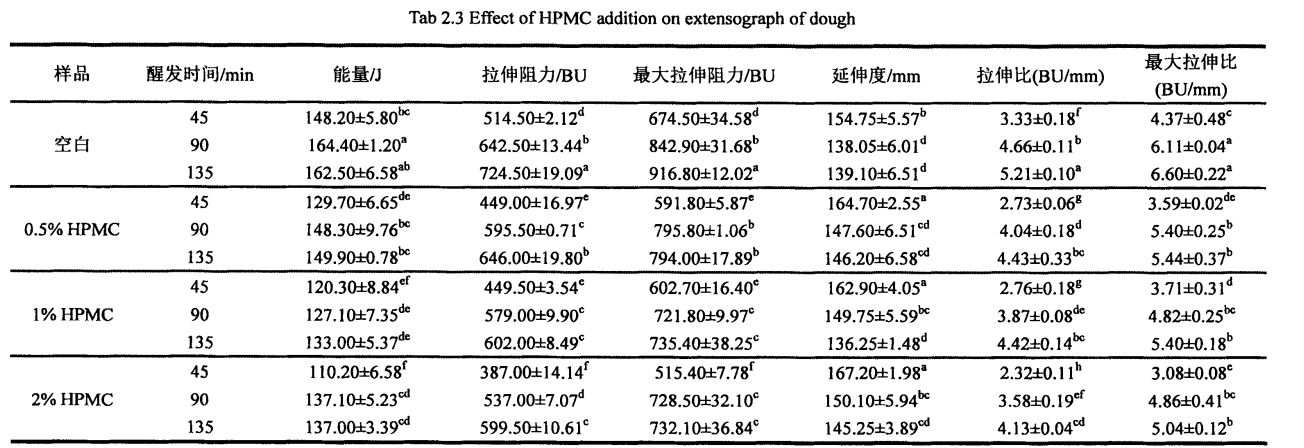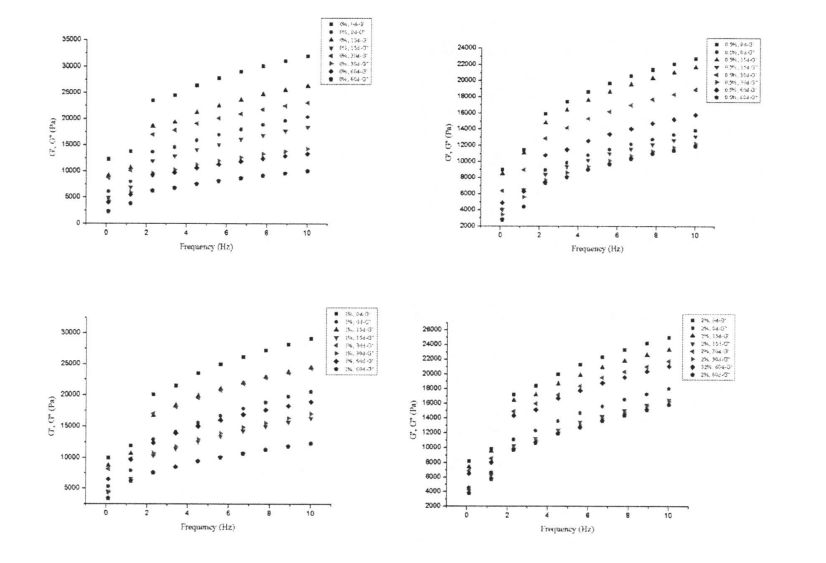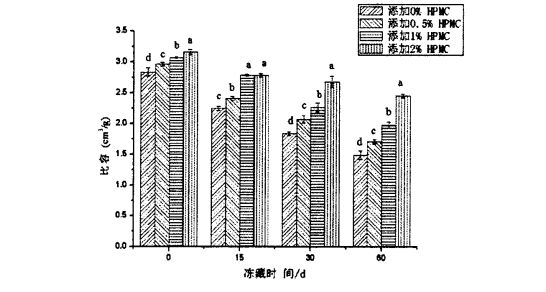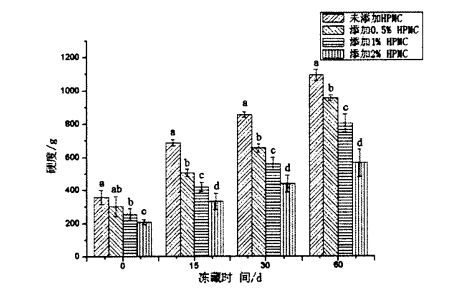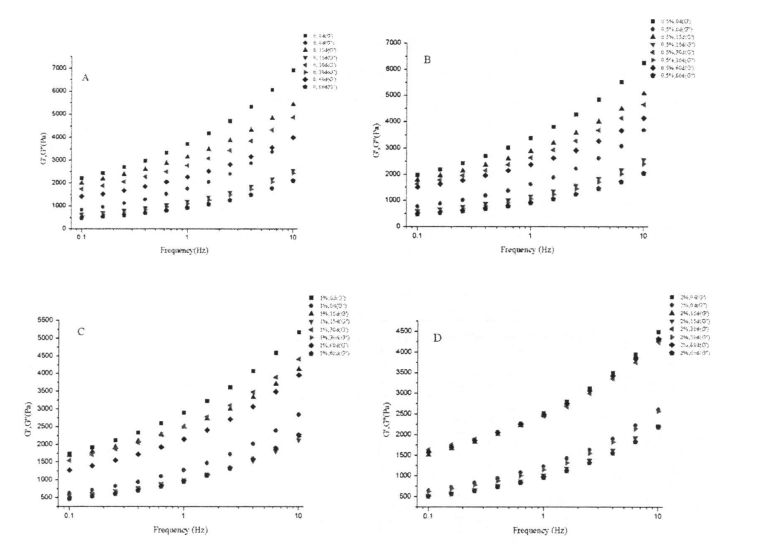Натиҷаҳои таҷрибавии ихтисос ва нишон доданд, ки илова кардани хосиятҳои сканерии коркарди хамир, ва сохтори шабакаи хамир нисбатан мӯътадил илова карда шуд ва сохтори шабакаи хамир нисбатан мӯътадил илова карда шуд. In addition, compared with the control group, the specific volume and elasticity of the steamed bread were improved, and the hardness was reduced after the frozen dough added with 2% HPMC was frozen for 60 days.
Гандуми гандум асоси моддӣ барои ташаккули сохтори шабакаи хамир мебошад. Experiments found that the addition of I--IPMC reduced the breakage of Yd and disulfide bonds between wheat gluten proteins during frozen storage. In addition, the results of low-field nuclear magnetic resonance and differential scanning the water state transition and recrystallization phenomena are limited, and the content of freezable water in the dough is reduced, thereby suppressing the effect of ice crystal growth on the gluten microstructure and its spatial conformation. Scanning electron microscope showed intuitively that the addition of HPMC could maintain the stability of gluten network structure.
Фаъолияти истеҳсоли гази гази хамиртуруши хамиртуруш ба сифати маҳсулоти орд дучор меояд. Through experiments, it was found that, compared with the control group, the addition of HPMC could better maintain the fermentation activity of yeast and reduce the increase rate of extracellular reduced glutathione content after 60 days of freezing, and within a certain range, The protective effect of HPMC was positively correlated with its addition amount.
Мундариҷа
Боби 1.СУФТАТ ..................................................................................................................................
1.1.7 Hydroxypropyl methyl cellulose (Hydroxypropyl methyl cellulose, I-IPMC) ………. 5
2.1 Муқаддима ..................................................................................................................................................................
2.3 Experimental results and discussion…………………………………………………………………… . 11
2.3.6 Таъсири NPMC ва вақти яхкунӣ дар сифати нон steamed ......................................................................................
Боби 3 Таъсири табларзаи HPMC оид ба сохтор ва хосиятҳои протеини гандум гандум дар шароити яхкунӣ ................................................................................................................................................................................................................................................................................................................................................................................................................................................................................................................
3.1 Муқаддима ...........................................................................................
3.2.4 Experimental methods ....................................................................................................... 25
3.3.1 Таъсири SHPMC ва вақти яхкунӣ дар хосиятҳои феологии массаи глутении тари тар ....................................................................
3.3.2 The effect of adding amount of HPMC and freezing storage time on the freezable moisture content (CFW) and thermal stability……………………………………………………………………. 30
3.3.3 Effects of HPMC addition amount and freezing storage time on free sulfhydryl content (C vessel) …………………………………………………………………………………………………………. . 34
3.3.6 Таъсири миқдори FIPMC ва вақти яхкунӣ дар гидрофобии рӯизаминӣ
4.1 Муқаддима .............................................................................. 44
4.2 Experimental materials and methods ................................................................................. 45
4.3 Analysis and discussion ........................................................................................................... 48
4.3.1 Content of basic components of wheat starch ……………………………………………………. 48
4.3.3 Effects of HPMC addition and freezing storage time on the shear viscosity of starch paste………………………………………………………………………………………………………………………………………. 52
4.3.6 Таъсири миқдори I-IPMC ва вақти иловагии яхкардашуда ва нигоҳдории яхкардашуда дар хосиятҳои термодинамикаи крахмал .................................................................. . 57
Chapter 5 Effects of HPMC addition on yeast survival rate and fermentation activity under frozen storage conditions………………………………………………………………………………………………. . 62
5.1Интсулгоҳ .................................................................................................... 62
5.2 Materials and methods ............................................................................................................ 62
5.2.2 Experimental methods . . . . . …………………………………………………………………………. 63
5.3 Results and Discussion ............................................................................................................... 64
5.3.3 The effect of adding amount of HPMC and freezing time on the content of glutathione in dough……………………………………………………………………………………………………………66. "
5.4 Chapter Summary ........................................................................................................................ 67
6.1 Conclusion ................................................................................................................................. . 68
6.2 Outlook .......................................................................................................................................... 68
Тасвири 1.1 Форматҳои сохтории метрокореллулоза . 6
Figure 2.4 The effect of HPMC addition and freezing time on the elasticity of steamed bread………………………………………………………………………………………………………………………………. . 20
Figure 3.1 The effect of HPMC addition and freezing time on the rheological properties of wet gluten…………………………………………………………………………………………………………………………. 30
Figure 3.2 Effects of HPMC addition and freezing time on the thermodynamic properties of wheat gluten………………………………………………………………………………………………………………. . 34
Диќањои 3.3 Таъсири XMC ва вақти яхкунӣ дар таркиби сулфияи озоди сулфайл гандум ................................................................................................................................................................................................................................................................................................................................................................................................ 35
Ҷадвали 3.4 Таъсири маблағи 1-и HPMC
Figure 3.7 The effect of HPMC addition and freezing time on the microscopic gluten network structure…………………………………………………………………………………………………………... . 43
Figure 4.1 Starch gelatinization characteristic curve ............................................................... 51
Figure 4.2 Fluid thixotropy of starch paste ................................................................................. 52
Дар тасвири 4.3 Таъсири илова кардани миқдори MC ва вақти яхкунӣ дар унисколастикии хамираи крахмал .............................................................................. 57
Дар расми 4,5 таъсири илова ва яхкунии HPMC ва яхдӯзӣ дар хосиятҳои термодинамикаи шаҳр .......................................................................................................................................................................................................................................................................................................................................................................................................................................... . 59
Тасвири 5.1 Таъсири SEPMC ва вақти яхкунӣ дар баландии хуни хамираи хамираи хамир ..................................................................................
Тасвири 5.2 Таъсири SEPMC ва вақти яхкунӣ дар сатҳи зинда мондан ...................................................................................................................................... 67
Figure 5.3 Microscopic observation of yeast (microscopic examination) …………………………………………………………………………………………………………………………. 68
Table 2.1 The basic ingredient content of wheat flour…………………………………………………. 11
Ҷадвали 2.4 Таъсири миқдори иловагии I-IPMC ва вақти яхкунӣ дар таркиби оби яхкунӣ (кории яхкардашуда) аз хамир яхкардашуда ....................................................
Ҷадвали 2.5 Таъсири миқдори иловагии I-IPMC ва нигоҳдории нигоҳдории нони I-IPMC дар хусусиятҳои матнии нони пухта ......................................................
Table 3.2 Effects of I-IPMC addition amount and freezing storage time on the phase transition enthalpy (Yi IV) and freezer water content (e chat) of wet gluten………………………. 31
Ҳуҷҷати 3.3. 33
Ҷадвали 3.5 Таъсири вақти SEPMC ва вақти яхкунӣ дар сохтори дуввуми гандумии гандум ............................................................................................................
Table 4.3 Effects of I-IPMC addition and freezing time on the shear viscosity of wheat starch paste…………………………………………………………………………………………………………………………. 55
Ҷадвали 4.4 Таъсири миқдори иловагии I-IPMC ва вақти нигоҳдории яхкардашуда дар хусусиятҳои термодинамикии gelatchinising Starch
1)Development of new characteristic steamed buns. Тавассути навовариҳои ашёи хом пухта ва иловаҳои моддаҳои фаъолонаи фаъол, навъҳои нави ҷӯшонидашуда таҳия карда шуданд, ки ҳам ғизо ва функсияро доранд. Established the evaluation standard for the quality of miscellaneous grain steamed bread by principal component analysis; Fu et a1. (2015) added lemon pomace containing dietary fiber and polyphenols to steamed bread, and evaluated the antioxidant activity of steamed bread; Hao & beta (2012) Барни Брэн Брэнл ва заҳмат кашида шуд (сарватманд дар модари биоиактивӣ) Раванди истеҳсоли нон пухта [5]; Shiau et a1. (2015) evaluated the effect of adding pineapple pulp fiber on dough rheological properties and steamed bread quality [6].
4) Тадқиқот дар бораи баланд бардоштани сифати ҷудошуда. Research on the addition and application of steamed bread quality improvers; mainly including additives (such as enzymes, emulsifiers, antioxidants, etc.) and other exogenous proteins [14], starch and modified starch [15], etc. The addition and optimization of the corresponding process It is particularly noteworthy that in recent years, through the use of some exogenous proteins and other additives, gluten-free (free. gluten) pasta products have been developed to meet the requirements of celiac disease (Dietary needs of patients with Coeliac Disease [16.1 cit.
5)Preservation and anti-aging of steamed bread and related mechanisms. Pan Lijun et al. (2010) optimized the composite modifier with good anti-aging effect through experimental design [l do not; Wang, et a1. (2015) таъсири дараҷаи полимерикизатсияҳои глутенизатсияро сафеда, намӣ ва крахмал-крахмалро аз ҳисоби таҳлили хусусиятҳои физикӣ ва химиявии нони пухта омӯхт. The results showed that water loss and starch recrystallization were the main reasons for the aging of steamed bread [20].
Frozen dough is a new technology for the processing and production of flour products developed in the 1950s. It mainly refers to the use of wheat flour as the main raw material and water or sugar as the main auxiliary materials. Мошинҳои пухта, печонидашуда, зуд ба ҳолати яхкардашуда ва дигар равандҳо ба ҳолати яхкардашуда ва дар. Маҳсулоти ниҳоӣ бояд ба ғорат, ки онро кафолат дода, пухта, пухта, пухта ва ғайра (251) лозим аст. [251].
Дар солҳои 90-ум технологияи коркарди яхкардашуда ба Чин ворид карда шуд. Бо рушди мунтазами илму техника ва такмили доимии сатҳи зиндагии мардум, технологияи аз ҷониби яхкардашуда дурнамои васеъ ва фазои бузурги рушд дорад
а) Чӣ гуна бад шудани сифати хамир яхкардашударо бо паҳншавии вақти нигоҳдории яхкардашуда, хусусан назорати ташаккул ва хосиятҳои се қисми асосии хамиртуруши хамир (крахмал, глутен ва хамиртуруш), то ҳол мушкил аст. Hotspots and fundamental issues in this research field;
в) беҳтар кардани сифати нави яхкардашудаи яхкардашуда, ки ба оптимизатсияи корхонаҳои истеҳсолӣ ва инноватсионӣ ва назорати маҳсулоти маҳсулот мусоидат мекунад, мусоидат менамояд. At present, it still needs to be further strengthened and expanded;
i.Study тағирот дар сохтор ва хосиятҳои хамир яхкардашуда бо тамдиди вақти нигоҳ доштани вақти нигоҳдории яхкунӣ, хусусан таъсири кристаллизатсия дар бораи маккорони биологӣ (протеин, крахмал, крахмал ва ғайра), масалан, кристаллизии ях. Ташаккул ва афзоиш ва муносибати он бо давлат ва тақсимоти об; changes in wheat gluten protein structure, conformation and properties [31]; changes in starch structure and properties; Тағйирот дар хамир ва хосиятҳои марбут ба ғайр аз ғайра 361.
II. Optimization of frozen dough production process, frozen storage conditions and formula. During the production of frozen dough, temperature control, proofing conditions, pre-freezing treatment, freezing rate, freezing conditions, moisture content, gluten protein content, and thawing methods will all affect the processing properties of frozen dough [37]. In general, higher freezing rates produce ice crystals that are smaller in size and more uniformly distributed, while lower freezing rates produce larger ice crystals that are not uniformly distributed. In addition, a lower freezing temperature even below the glass transition temperature (CTA) can effectively maintain its quality, but the cost is higher, and the actual production and cold chain transportation temperatures are usually small. In addition, the fluctuation of the freezing temperature will cause recrystallization, which will affect the quality of the dough.
III. Бо истифода аз иловаҳо барои такмил додани сифати маҳсулоти хамир яхкардашуда. In order to improve the product quality of frozen dough, many researchers have made explorations from different perspectives, for example, improving the low temperature tolerance of material components in frozen dough, using additives to maintain the stability of the dough network structure [45.56], etc. Among them, the use of additives is an effective and widely used method. Mainly include, i) enzyme preparations, such as, transglutaminase, O [. Amylase; ii) emulsifiers, such as monoglyceride stearate, DATEM, SSL, CSL, DATEM, etc.; iii) antioxidants, ascorbic acid, etc.; iv) polysaccharide hydrocolloids, such as guar gum, yellow Originalgum, gum Arabic, konjac gum, sodium alginate, etc.; v) other functional substances, such as Xu, et a1. (2009) added Ice-structuring Proteins to wet gluten mass under freezing conditions, and studied its protective effect and mechanism on the structure and function of gluten protein [y71.
Ⅳ. Breeding of antifreeze yeast and application of new yeast antifreeze [58-59]. Sasano, et a1. (2013) obtained freeze-tolerant yeast strains through hybridization and recombination between different strains [60-61], and S11i, Yu, & Lee (2013) studied a biogenic ice nucleating agent derived from Erwinia Herbicans used to protect the fermentation viability of yeast under freezing conditions [62J.
HydroxyPropil MyLulatey (HydroxyPrope Metlulatey Croslenty, HPMC) ба таври табиӣ ба таври табиӣ ба даст омадааст. Дафтари Иёлоти Муттаҳида (Иёлоти Муттаҳида) HPMC-ро ба се категория дар қатори паҳлӯии HPMC тақсим мекунад: E (гyprastellock 22006) ва K (гипоммелоза 2208) тақсим мекунад.
At present, the application and large-scale production of frozen dough processing technology in my country as a whole is still in the development stage. Ҳамзамон, марҳаматҳо ва норасоии худи хамир яхкардашуда вуҷуд дорад. Ин омилҳои мукаммал, бешубҳа, аризаи минбаъдаро ва тарғиби хамир яхкардашуда маҳдуд мекунанд. on the other hand,this also means that the application of frozen dough has great potential and broad prospects, especially from the perspective of combining frozen dough technology with the industrialized production of traditional Chinese noodles (non-)fermented staple food, to develop more products that meet the needs of Chinese residents. It is of practical significance to improve the quality of the frozen dough based on the characteristics of Chinese pastry and the dietary habits, and is suitable for the processing characteristics of Chinese pastry.
Умуман боварӣ дорад, ки хамир як системаи маъмулии моддии мураккаб бо хусусиятҳои фосилаи, бисёрфаск, марҳилаи гуногун ва миқёс аст.
1) Навъи нави коллонипи гидрокилияро интихоб кунед, гидроксропулоза (HPMC) ҳамчун иловагиҳо (HPMC) ҳамчун иловаҳо (HPMC) -ро дар зери як вақт яхкардашуда (0, 15, 30, 60 рӯз) интихоб кунед; ҳамон шартҳои зер. (0%, 0.5%, 1%, 2%; the same below) on the rheological properties and microstructure of frozen dough, as well as on the quality of the dough product - steamed bread (including the specific volume of steamed bread) , texture), investigate the effect of adding HPMC to the frozen dough on the processing properties of the dough and the quality of steamed bread, and evaluate the improvement effect of HPMC on the processing properties of the frozen dough;
Generally speaking, the material composition of dough used for making fermented flour products mainly includes biological macromolecular substances (starch, protein), inorganic water, and yeast of organisms, and is formed after hydration, cross-linking and interaction. Системаи моддии устувор ва мураккаб бо сохтори махсус таҳия шудааст. Numerous studies have shown that the properties of the dough have a significant impact on the quality of the final product. Therefore, by optimizing the compounding to meet the specific product and it is a research direction to improve the dough formulation and technology of the quality of the product or food for use; on the other hand, improving or improving the properties of dough processing and preservation to ensure or improve the quality of the product is also an important research issue.
Тавре ки дар муқаддимавӣ илова карда шуд, илова кардани HPMC ба системаи хамир ва санҷиши он ба хосиятҳои хамир (Фиёдӣ, дуршавӣ, регеология ва сифати маҳсулоти ниҳоӣ) ду омӯзиши зич дорад.
Zhongyu Wheat Flour Binzhou Zhongyu Food Co., Ltd.; Angel Active Dry Yeast Angel Yeast Co., Ltd.; HPMC (methyl substitution degree of 28%.30%, hydroxypropyl substitution degree of 7%.12%) Aladdin (Shanghai) Chemical Reagent Company; Ҳама режими химиявӣ, ки дар ин озмоиш истифода мешаванд, аз синфи таҳлилӣ мебошанд;
Powder meter. Д
Extensometer. Д
Истеъсолкунанда
Тибқи иттилои ГБ 50093.2010.5-2010, GB 5009.29.9008, GB / T2010.2010.2010.2010.2010] ҷузъҳои асосии орди гандумӣ, сафеда, сафеда ва сершуморро муайян кунед.
Refer to the dough making process of GB/T 17320.1998 [84]. Weigh 450 g of flour and 5 g of active dry yeast into the bowl of the dough mixer, stir at low speed to fully mix the two, and then add 245 mL of low-temperature (Distilled water (pre-stored in the refrigerator at 4°C for 24 hours to inhibit the activity of yeast), first stir at low speed for 1 min, then at medium speed for 4 min until dough is formed. Take out the dough and divide it into about 180g / portion, knead it into a cylindrical shape, then seal it with a ziplock bag, and put it in. Freeze at 18°C for 15, 30, and 60 days. Add 0.5%, 1%, 2% (w/w, dry basis) HPMC to replace the corresponding proportion of flour quality to make dough, and the rest of the production methods remain unchanged. The 0-day frozen storage (unfrozen storage) was used ҳамчун гурӯҳи назоратии назорат.
Weigh a sample of about 15 mg of the central part of the fully melted dough, seal it in an aluminum crucible (suitable for liquid samples), and measure it with a Differential Scanning Calorimetry (DSC). Параметрҳои мушаххаси барнома гузошта шудаанд. Тавре ки аз паи зеринҳо: эксмилизатсияи аввал то 5 дақиқа, сипас ба андозаи 10 дақ .30 ° C бо суръати 10 дақ. Using the blank aluminum crucible as a reference, the obtained DSC curve was analyzed using the analysis software Universal Analysis 2000, and the melting enthalpy (day) of the ice crystal was obtained by integrating the peak located at about 0°C. Freezable water content (CFW) is calculated by the following formula [85.86]:
Among them, 厶 represents the latent heat of moisture, and its value is 334 J Dan; MC (мундариҷаи умумӣ) таркиби умумии маводи моеъро дар хамир нишон медиҳад (тибқи GB 50033.2010T78]). Ҳар як намуна се маротиба такрор карда шуд.
Пас аз вақти мувофиқ, хамир яхкардашуда бардошта шуд, аввал дар яхдон 4 ° C баробарӣ карда шуд ва сипас дар ҳарорати хонагӣ ҷойгир карда шуд, то хамир яхкардашуда. Хамирро ба тақрибан 70 грамм тақсим кунед, онро хам кунед, онро ба қуттии доимӣ гузоред ва онро барои 60 дақиқа дар 30 ° C ва намии нисбии 85% исбот кунед. After proofing, steam for 20 min, and then cool for 1 h at room temperature to evaluate the quality of steamed bread.
All experiments were repeated at least three times unless otherwise specified, and the experimental results were expressed as the mean (Mean) ± standard deviation (Standard Deviation). Сптизмҳои SPSS 19 барои таҳлили ихтилофот (таҳлили ихтилоф (таҳлил, ANOVA) истифода мешуд ва сатҳи аҳамияте буд, ки сатҳи аҳамият о O. 05; Use Origin 8.0 to draw relevant charts.
J (2% HPMC added). Ҳамзамон, ҳадди аксар аз ҳадде, ки хамир аз 674.50-A: 34,50 ва 3,80 ± 16.80 - A: 5.80. Бо вуҷуди ин, сабукшавии хамир аз 154,75 + 7.57 митти (холии 0,50-юм), ва 1 67,50-юм (1% HPMC илова карда шуд), ва 1 67.20-юм: 1.98 дақиқа (2% HPMC илова карда шуд). This may be due to the increase of the plasticizer-water content by adding HPMC, which reduces the resistance to the deformation of the gluten protein molecular chain, or the interaction between HPMC and the gluten protein molecular chain changes its stretching behavior, which in turn affects It improves the tensile properties of the dough and increases the extensibility of the dough, which will affect the quality (eg, specific volume, texture) of the final product.
Хусусиятҳои ревокораи хамир ҷанбаи муҳими хосиятҳои хамир мебошанд, ки метавонанд хусусиятҳои ҳамаҷонибаи хамирро инъикос кунанд, ба монанди акососистӣ, субот ва коркарди хислатҳои коркард ва инчунин тағирот ҳангоми коркард ва нигоҳдорӣ.
Ҳаҷми муайяни нони пухта метавонад пайдошавии пайдарпай ва сифати сенсориро аз нон бизашад. Ҳаҷми нави нони пухта, ҳаҷми нони пухта аз ҳамон сифат, ва ҳаҷми мушаххас ба намуди зоҳирӣ, ранг, матн ва баҳодиҳии ҳомиладории ғизо таъсири муайян дорад. Generally speaking, steamed buns with larger specific volume are also more popular with consumers to a certain extent.
Ҳаҷми муайяни нони пухта метавонад пайдошавии пайдарпай ва сифати сенсориро аз нон бизашад. Ҳаҷми нави нони пухта, ҳаҷми нони пухта аз ҳамон сифат, ва ҳаҷми мушаххас ба намуди зоҳирӣ, ранг, матн ва баҳодиҳии ҳомиладории ғизо таъсири муайян дорад. Generally speaking, steamed buns with larger specific volume are also more popular with consumers to a certain extent.
Аз тарафи дигар, бо дароз кардани вақти нигоҳдории сабзаи яхкардашуда, сахттар аз он ба таври назаррас сохта шудааст (P <0.05), дар ҳоле ки чандирии ба таври назаррас коҳиш ёфтааст (P <0.05). Бо вуҷуди ин, сахтӣ аз хамираи яхкардашуда бе иловашуда аз 358.267 ± 42.103 гред (нигаҳдории яхкардашуда барои 1092.014 ± 34.254 гр (нигаҳдории яхкардашуда барои 60 рӯз);

Модули гидроксельлсил (HPMC) як навъ маҷмӯи гидрофилӣ мебошад ва тадқиқоти татбиқи он дар хамир яхкардашуда бо ғизои яхкардашуда бо ғизои яхкардашуда (ба монанди нони пухта) ҳамчун маҳсулоти ниҳоӣ ҳанӯз намерасад. The main purpose of this study is to evaluate the effect of HPMC improvement by investigating the effect of HPMC addition on the processing properties of frozen dough and the quality of steamed bread, so as to provide some theoretical support for the application of HPMC in steamed bread and other Chinese-style flour products. The results show that HPMC can improve the farinaceous properties of the dough. When the addition amount of HPMC is 2%, the water absorption rate of the dough increases from 58.10% in the control group to 60.60%; 2 min increased to 12.2 min; at the same time, the dough formation time decreased from 2.1 min in the control group to 1.5 mill; the weakening degree decreased from 55 FU in the control group to 18 FU. In addition, HPMC also improved the tensile properties of the dough. With the increase in the amount of HPMC added, the elongation of the dough increased significantly; significantly reduced. In addition, during the frozen storage period, the addition of HPMC reduced the increase rate of the freezable water content in the dough, thereby inhibiting the damage to the dough network structure caused by ice crystallization, maintaining the relative stability of the dough viscoelasticity and the integrity of the network structure, thereby improving the stability of the dough network structure. The quality of the final product is guaranteed.
In addition, from a microscopic point of view, the formation of the three-dimensional network structure of dough is accompanied by the formation of intermolecular and intramolecular covalent bonds (such as disulfide bonds) and non-covalent bonds (such as hydrogen bonds, hydrophobic forces) [103]. Гарчанде ки энергияи вомбарги дуюм
For frozen dough, under freezing conditions, the formation and growth of ice crystals (crystallization and recrystallization process) will cause the dough network structure to be physically squeezed, and its structural integrity will be destroyed, and microscopically. Accompanied by changes in the structure and properties of gluten protein [105'1061. As Zhao, et a1. (2012), ки бо тамдиди вақти яхкардашуда ва радиус зиреҳи протеини глютенӣ коҳиш ёфтааст [1076, ки протеини глютенӣ қисман эътибори онро дорад. In addition, the spatial conformational changes and thermodynamic properties of gluten protein will affect the dough processing properties and product quality. Аз ин рӯ, дар ҷараёни нигоҳубини яхкунӣ, муайян кардани тағйири тағйири тағйири тағйири тағйири тағйири тағйири тағйири тағйири тағйири тағйири тағйири тағиротҳои обтаъминкунӣ (ҳолати яхбандӣ) ва сохтор ва хосиятҳои протеини глютен дар шароити мухталифи нигоҳдории яхмос.
Gluten Anhui Rai Fu Niang Fook Co., LTD.; Hydroxypropyl Methylcellulose (HPMC, same as above) Aladdin Chemical Reagent Co., Ltd.
PQ00 1 АСОСИ КӮДАКИ НАВ
Истеъсолкунанда
3.2.4.1 муайян кардани ҷузъҳои асосии глютен
Тибқи усули ботлоқ (2003) [1081, калориметр дифференсиалӣ (DSC Qual Q.200) дар ин озмоиш барои чен кардани хусусиятҳои дахлдори одатҳо истифода мешуд.
3.2.4.5 Муайян кардани мундариҷаи озоди сулфайл (в) гандум гандум
Дар байни онҳо, м функсияи маблағи қаламрави экспресс бо вақт (t) ҳамчун тағирёбандаи мустақил; Yang) is the function of the hydrogen proton number density with the relaxation time (D) as the independent variable.
3.2.4.8 Таъмини гидрофобии сатҳи протеини дурахшон
3. Натиҷаҳо ва муҳокима
Афзоиши CFW асосан аз ҳисоби раванди такроркунӣ ва тағир додани мувофиқат сафед кардани сафеда, ки ҳолати обро аз оби бева яхдор ба оби яхмӯҳлат иваз мекунад. This change in moisture state allows ice crystals to be trapped in the interstices of the network structure, the network structure (pores) gradually become larger, which in turn leads to greater squeezing and destruction of the walls of the pores. Бо вуҷуди ин, фарқияти назарраси 0w 0W дар байни интихоб бо мундариҷаи муайяни HPMC ва намунаҳои холӣ нишон медиҳад, ки HPMC метавонад зарари кристаллҳои яхро ба сохтори шабакавии глутен нигоҳ дошта, ҳатто ба сифати маҳсулот монеъ шавад. бадтар шудан.

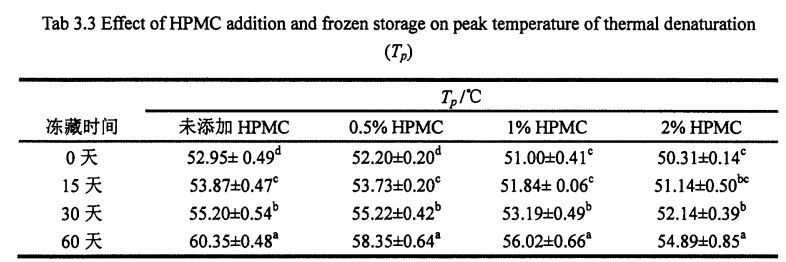
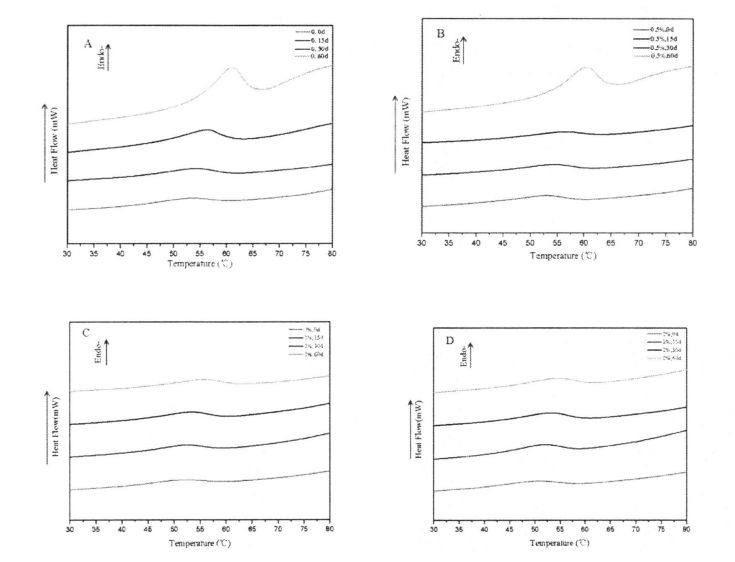
Fig 3.2 Typical DSC thermograms of gluten proteins with 0%HPMC(A);with O.5%HPMC(B); with 1%HPMC(C);with 2%HPMC(D)after different time of frozen storage,from 0d to 60d indicated from the lowest curve to the highest one in each graph. Note: A is the DSC curve of wheat gluten without adding HPMC; B is the addition of O. DSC curve of wheat gluten with 5% HPMC; C is the DSC curve of wheat gluten with 1% HPMC; D is the DSC curve of wheat gluten with 2% HPMC 3.3.3 Effects of HPMC addition amount and freezing time on free sulfhydryl content (C-SH) Intermolecular and intramolecular covalent bonds are very important for the stability of dough network structure. A disulfide bond (-SS-) is a covalent linkage formed by dehydrogenation of two free sulfhydryl groups (.SH). Glutenin is composed of glutenin and gliadin, the former can form intramolecular and intermolecular disulfide bonds, while the latter can only form intramolecular disulfide bonds [1241] Therefore, disulfide bonds are an intramolecular/intermolecular disulfide bond. роҳи муҳими пайвастшавӣ. Compared to adding 0%, O. The C-SH of 5% and 1% HPMC without freezing treatment and the C-SH of gluten after 60 days of freezing have different degrees of increase respectively. Specifically, the face with no HPMC added gluten C. SH increased by 3.74 "mol/g to 8.25 "mol/g, while C.sh, shellfish, with gluten supplemented with 0.5% and 1% HPMC increased by 2.76 "mol/g to 7.25""mol/g and 1.33 "mol/g to 5.66 "mol/g (Fig. 3.3). Zhao, et a1. (2012) found that after 120 days of frozen storage, the content of free thiol groups increased significantly [ 1071. It is worth noting that the C-SH of gluten protein was significantly lower than that of other frozen storage periods when the freezing period was 15 days, which may be attributed to the freezing shrinkage effect of gluten protein structure, which makes the More intermolecular and intramolecular disulfide bonds were locally formed in a shorter freezing time [1161. Wang, et a1. (2014) found that the C-SH of glutenin-rich proteins was also significantly increased after 15 days of freezing. Decreased [1251. However, the gluten protein supplemented with 2% HPMC did not increase significantly except for C-SH, which also decreased significantly at 15 days, with the extension of freezing time.
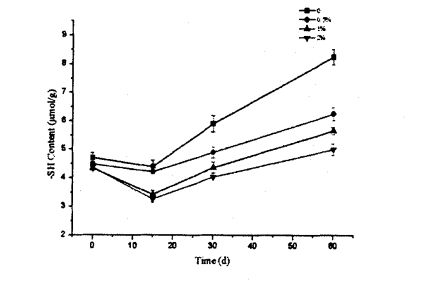
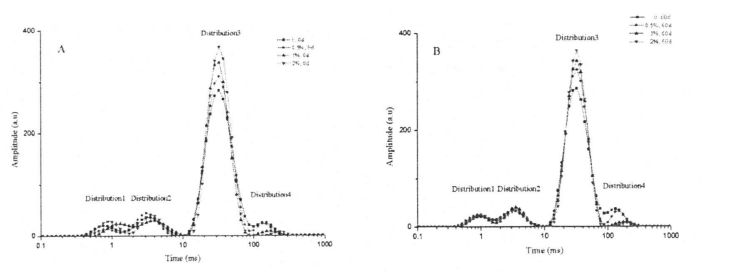
Илова бар ин, баландии тақсимоти массаи глютении тари тари бо мундариҷаи гуногуни HPMC хеле фарқ дошт (расми 3.4, A) ва мундариҷаи нисбии оби озод бо маблағи HPMC илова карда шуд. This is just the opposite of the Dang distribution. Therefore, this variation rule indicates that HPMC has water holding capacity and converts free water to confined water. However, after 60 days of freezing, the height and area of T24 distribution increased to varying degrees, which indicated that the water state changed from restricted water to free-flowing state during the freezing process. Ин асосан аз тағйири мутобиқати протеини глутенӣ ва нест кардани воҳиди "қабати" дар сохтори глютен, ки ҳолати оби маҳдудшударо дар он тағир додааст, вобаста аст. Although the content of freezable water determined by DSC also increases with the extension of freezing storage time, however, due to the difference in the measurement methods and characterization principles of the two, the freezable water and free water are not completely equivalent. For the wet gluten mass added with 2% HPMC, after 60 days of freezing storage, none of the four distributions showed significant differences, indicating that HPMC can effectively retain the water state due to its own water-holding properties and its interaction with gluten. and stable liquidity.

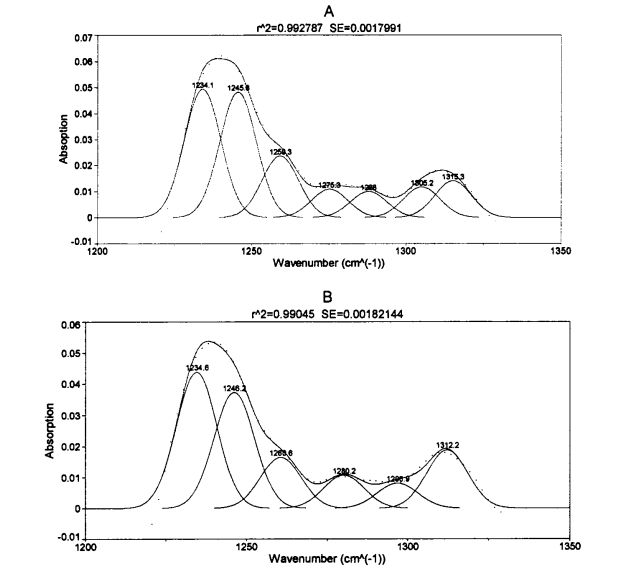
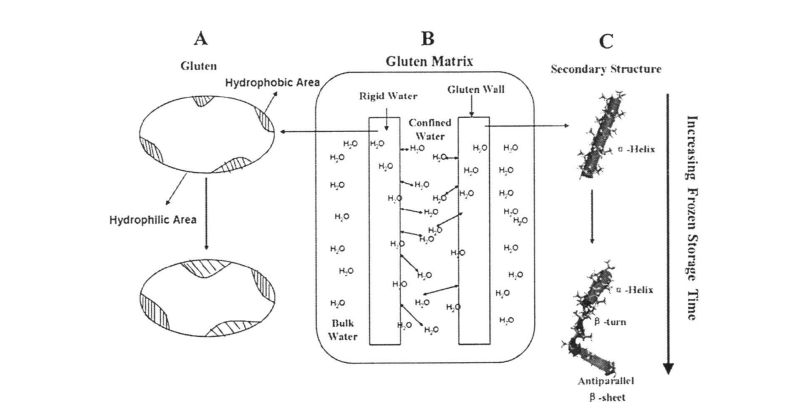
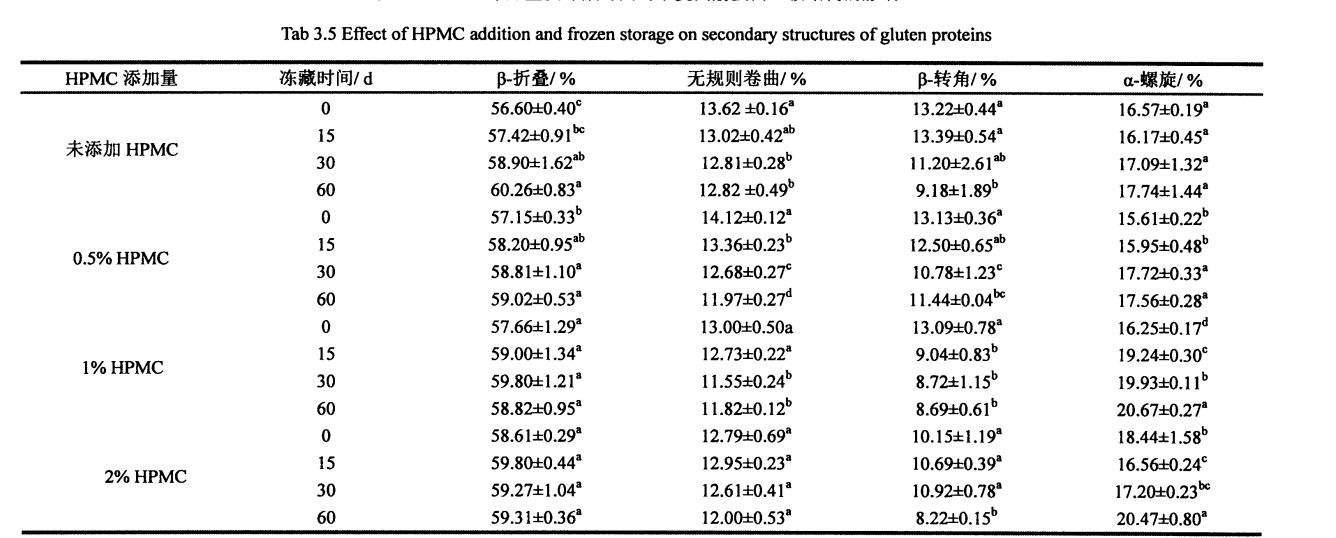
All samples with the extension of freezing time, p. The relative contents of the corners were significantly reduced. This shows that β-turn is very sensitive to freezing treatment [135. 1361], and whether HPMC is added or not has no effect. Хуб ва et a1. (2005) proposed that the β-chain turn of gluten protein is related to the β-turn space domain structure of the glutenin polypeptide chain [l 37]. Except that the relative content of random coil structure of gluten protein added with 2% HPMC had no significant change in frozen storage, the other samples were significantly reduced, which may be caused by the extrusion of ice crystals. In addition, when frozen for 0 days, the relative contents of α-helix, β-sheet and β-turn structure of gluten protein added with 2% HPMC were significantly different from those of gluten protein without HPMC. This may indicate that there is an interaction between HPMC and gluten protein, forming new hydrogen bonds and then affecting the conformation of the protein; or HPMC absorbs the water in the pore cavity of the protein space structure, which deforms the protein and leads to more changes between the subunits. close. The increase of the relative content of β-sheet structure and the decrease of the relative content of β-turn and α-helix structure are consistent with the above speculation. During the freezing process, the diffusion and migration of water and the formation of ice crystals destroy the hydrogen bonds that maintain the conformational stability and expose the hydrophobic groups of proteins. In addition, from the perspective of energy, the smaller the energy of the protein, the more stable it is. At low temperature, the self-organization behavior (folding and unfolding) of protein molecules proceeds spontaneously and leads to conformational changes.

HPMC метавонад бо гурӯҳҳои гидрофилӣ тавассути вомбаргҳои сафеда якҷоя шавад ва ба ин васила хусусиятҳои рӯизаминиро иваз мекунад ва ҳангоми маҳдуд кардани гурӯҳҳои гидрофобӣ (Ҷадвали 3.6).
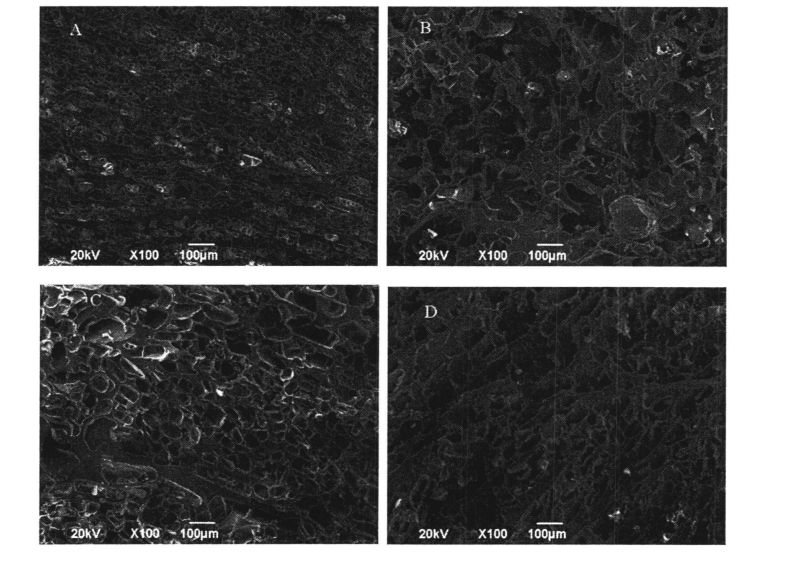
Тасвири 3,7 Тасвири Микдори миксер аз хамираи глютен, (а) хамир gluten-ро бо 0 6% HPMC нишон дод, ки 2% хамираи глютенро бо 2% нишон додашуда бо 2% HPMC барои 60%
Ин таҷриба аз рагологияи хамир ва сафедаи глютен бо илова кардани hpmc бо парвариши HPMC бо мундариҷаи гуногун (0%, 0,5% ва 2,5% ва 15, 30, 30, 30,5% ва 60 рӯз) таҳқиқ карда шуд. properties, thermodynamic properties, and effects of physicochemical properties. The study found that the change and redistribution of water state during the freezing storage process significantly increased the freezable water content in the wet gluten system, which led to the destruction of the gluten structure due to the formation and growth of ice crystals, and ultimately caused the processing properties of the dough to be different. Deterioration of product quality. The results of frequency scanning showed that the elastic modulus and viscous modulus of the wet gluten mass without adding HPMC decreased significantly during the freezing storage process, and the scanning electron microscope showed that its microstructure was damaged. The content of free sulfhydryl group was significantly increased, and its hydrophobic group was more exposed, which made the thermal denaturation temperature and surface hydrophobicity of gluten protein significantly increased. However, the experimental results show that the addition of I-IPMC can effectively inhibit the changes in the structure and properties of wet gluten mass and gluten protein during freezing storage, and within a certain range, this inhibitory effect is positively correlated with the addition of HPMC. This is because HPMC can reduce the mobility of water and limit the increase of the freezable water content, thereby inhibiting the recrystallization phenomenon and keeping the gluten network structure and the spatial conformation of the protein relatively stable. This shows that the addition of HPMC can effectively maintain the integrity of the frozen dough structure, thereby ensuring product quality.
Starch is one of the main components of flour, and its content is as high as about 75% (dry basis). Ҳамзамон, ҳамчун карбогидрат, крахмал, крахмал инчунин маводи асосии нерӯи барқ дар ғизо аст. Дар системаи хамир, крахмал асосан паҳн карда мешавад ва ба сохтори шабакавии протеини дурахшон замима карда мешавад. Ҳангоми коркард ва анбор, крахмалҳо аксар вақт аз желатия ва марҳилаҳои пиронсолӣ мегузаранд.
In general, starch gelatinization is affected by the source and type of starch, the relative content of amylose and amylopectin in starch, whether starch is modified and the method of modification, addition of other exogenous substances, and dispersion conditions (such as The influence of salt ion species and concentration, pH value, temperature, moisture content, etc.) [142-150]. Аз ин рӯ, вақте ки сохтори крахмал (морфологияи рӯизаминӣ, сохтори кристаллӣ ва ғайра) иваз карда мешавад, хосиятҳои гелятсиякунӣ, хосиятҳои пиронсол, ҳаҷмҳо ва ғайра ба таври амудӣ таъсир мерасонанд.
BSAL24S Созиши электрониён
БАТ / BD-272SC ях
Bcd-201lant яхдон
Истеъсолкунанда
4.2.3.3 Хусусиятҳои термодинамик
Пас аз вақти муносиб, намунаҳо гирифта шуданд, ки пурра обхезонида шуда, дар танӯр дар 40 ° C барои 48 соат хушк карда шуданд. Дар ниҳоят, он тавассути ҷумбонидани як ҷумлаи 100 торт буд, то интихоби хокаи сахт барои истифода (мувофиқ барои санҷиши XRD мувофиқ бошад). See Xie, et a1. (2014) method for sample preparation and determination of thermodynamic properties '1611, weigh 10 mg of starch sample into a liquid aluminum crucible with an ultra-micro analytical balance, add 20 mg of distilled water in a ratio of 1:2, press and seal it and place it at 4 °C In the refrigerator, equilibrated for 24 h. Freeze at 18°C (0, 15, 30 and 60 days). 0,5%, 1,5%, 1%, 2%, 2% (W / W) HPMC-ро иваз кунед, то сифати мувофиқи крахмал ва дигар усулҳои омодагӣ бетағйир боқӣ монад. After the freezing storage time is over, take out the crucible and equilibrate at 4 °C for 4 h.
0,1 г хок хушк, заминро ба даст оред, 10 мл оби тозаро ба дӯкон илова кунед, бигзор онро дар ҳарорати доимӣ ҷойгир кунед. After 30 min, after gelatinization is complete, take out the centrifuge tube and place it in an ice bath for 10 min for rapid cooling. Finally, centrifuge at 5000 rpm for 20 min, and pour off the supernatant to obtain a precipitate. Swelling Power=precipitation mass/sample mass [163].


The final viscosity of starch suspension without adding HPMC increased from 794.62 ± 12.84 CP (frozen storage for 0 days) to 1413.15 ± 45.59 CP (frozen storage for 60 days). The peak viscosity of starch suspension increased from 882.24 ± 22.40 CP (frozen storage for 0 days) to 1322.86 ± 36.23 CP (frozen storage for 60 days); the peak viscosity of starch suspension added with 1% HPMC The viscosity increased from 846.04 ± 12.66 CP (frozen storage 0 days) to 1291.94 ± 88.57 CP (frozen storage for 60 days); Ва қуллаи гелятсия
P (frozen storage for 0 days) to 856.38 ± 16.20 CP (frozen storage for 60 days); the retrogradation value of starch suspension added with 0.5% HPMC increased from 427 .29±14.50 CP (frozen storage for 0 days) increased to 740.93±35.99 CP (frozen storage for 60 days); Арзиши ақибни боздоштани боздоштани гузашта бо 1% HPMC аз 360.48 ± 41 афзудааст. 39 CP (frozen storage for 0 days) increased to 666.46 ± 21.40 CP (frozen storage for 60 days); while the retrogradation value of starch suspension added with 2% HPMC increased from 357.85 ± 21.00 CP (frozen storage for 60 days). 0 days) increased to 515.51 ± 20.86 CP (60 days frozen).

4.3.3 Таъсири маблағи HPMC HPMC ва вақти нигоҳдории яхкардашуда дар часпакҳои Sharch Starch
Таъсири сатҳи sear дар тасвири намоёни часпак (часпак) -и моеъ бо санҷиши устувори ҷараён ва сохтори моддӣ ва хосиятҳои моеъ мувофиқ карда шуд. Table 4.3 lists the equation parameters obtained by nonlinear fitting, that is, the consistency coefficient K and the flow characteristic index D, as well as the influence of the addition amount of HPMC and the freezing storage time on the above parameters K gate.


Аз тарафи дигар, барои крахмал бе нигаҳдории яхкардашуда, қимати кплик, аз 78.240 ± 1.640 ± 1.660 ± 1.661 ПАД (бе илова кардани HPMC). 683±1.035 Pa ·sn (add 0.5% Hand MC), 43.122±1.047 Pa ·sn (add 1% HPMC), and 13.926±0.330Pa·Sn (add 2% HPMC), while the n value increased significantly, from 0.277 ± 0.011 (without adding HPMC) to 0.277 ± 0.011 in turn. 310 ± 0.009 (add 0.5% HPMC), O. 323 ± 0.013 (add 1% HPMC) and O. 43 1 ± 0.0 1 3 (adding 2% HPMC), which is similar to the experimental results of Techawipharat, Suphantharika, & BeMiller (2008) and Turabi, Sumnu, & Sahin (2008), and the increase of n value shows that the addition of HPMC makes the fluid has a tendency to change from pseudoplastic to Newtonian [168'1691]. at the same time, For the starch stored frozen for 60 days, the K, n values showed the same change rule with the increase of HPMC addition.
Бо вуҷуди ин, бо тамдиди вақти нигоҳдории яхкунӣ, арзишҳои к ва n баланд бардошта шуданд, ки арзиши кории крас аз 78.240 ± 1.661 ПАЛАТ (UNDED) мутаносибан 95,570 ± 1. 2.421 ПАЛЛАТ (Не 60 рӯз), аз 65.125 ± 1.035 ± 1.047 ПАЛС (илова кардани 1% HPMC, 0 рӯз) зиёд шуд. 56.538±1.378 Pa ·sn (adding 1% HPMC, 60 days) ), and increased from 13.926 ± 0.330 Pa ·sn (adding 2% HPMC, 0 days) to 16.064 ± 0.465 Pa ·sn (adding 2% HPMC, 60 days); 0.277 ± 0.011 (without adding HPMC, 0 days) rose to O. 334±0.014 (no addition, 60 days), increased from 0.310±0.009 (0.5% HPMC added, 0 day) to 0.336±0.014 (0.5% HPMC added, 60 days), from 0.323 ± 0.013 (add 1% HPMC, 0 days) to 0.340 ± 0.013 (add 1% HPMC, 60 days), and from 0.431 ± 0.013 (add 1% HPMC, 60 days) 2% HPMC, 0 days) to 0.404+0.020 (add 2% HPMC, 60 days). By comparison, it can be found that with the increase of the addition amount of HPMC, the change rate of K and Knife value decreases successively, which shows that the addition of HPMC can make the starch paste stable under the action of shearing force, which is consistent with the measurement results of starch gelatinization characteristics. пайваста.
4.3.4 Таъсири маблағи HPMC HPMC ва вақти нигоҳдории яхкардашуда дар Viscoelicatical Sectch Starch

The swelling ratio of starch can reflect the size of starch gelatinization and water swelling, and the stability of starch paste under centrifugal conditions. Чӣ тавре ки дар расми 4.4, крахмал бидуни нигоҳдории яхкардашуда, нерӯи дабдабаноки крахмал аз 8.969 + 0.099 (бе илова кардани HPMC), ки пас аз jelatination, крахмал зиёд мешавад, ки ба хулосаи он мувофиқат мекунад starch gelatinization characteristics. However, with the extension of frozen storage time, the swelling power of starch decreased. Дар муқоиса бо 0 рӯзҳои анбори яхкардашуда, дабдабаноки дабдабаноки крахмал аз 8.969-A: 7.099 то 7.059 то 7,097 то 60 рӯз, мутаносибан. .007 (Не hpmc илова карда шудааст), аз 9.269 то 7.284 + 0.157 то 8,27,014 коҳиш ёфтааст (илова карда 1% HPMC), 8.069 то 8.064 + 0.004 коҳиш ёфтааст (илова кардани 2% HPMC). Натиҷаҳо нишон доданд, ки гранулҳои крахмал пас аз нигоҳдории яхкунӣ хароб шуда буданд, ки дар натиҷа бориши як қисми крахмал ва маркази ҳалшаванда. Therefore, the solubility of starch increased and the swelling power decreased. Илова бар ин, пас аз нигоҳдорӣ, крахмал крахмал, субот ва иқтидори нигоҳ доштани об коҳиш ёфт ва амали омехтаи ин ду қудрати варамро коҳиш дод [1711]. Аз тарафи дигар, бо афзоиши грант паст шудани геррати крахмал кам шуд, ки HPMC метавонад миқдори крахмалро, ки ҳангоми нигоҳдории яхкардашуда кам карда метавонад, коҳиш диҳад ва дараҷаи зарари крахмалро боз кунад.
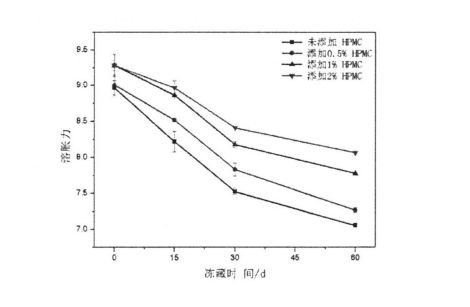
The gelatinization of starch is an endothermic chemical thermodynamic process. Аз ин рӯ, DSC аксар вақт барои муайян кардани ҳарорати фарёд (мурда), ҳарорати ҳавзаи қулла (ба), ҳарорати ниҳоӣ ва Желатизатсия ба утоқи желятсияи креленизатсия. (TC). Table 4.4 shows the DSC curves of starch gelatinization with 2% and without HPMC added for different freezing storage times.
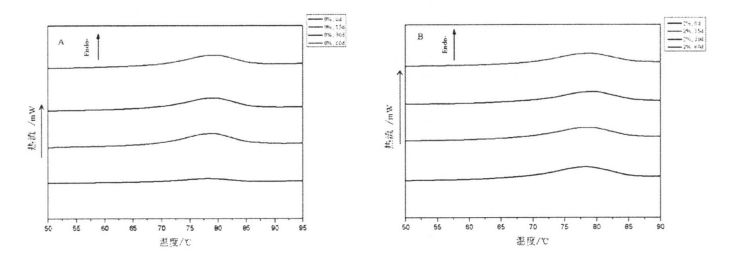
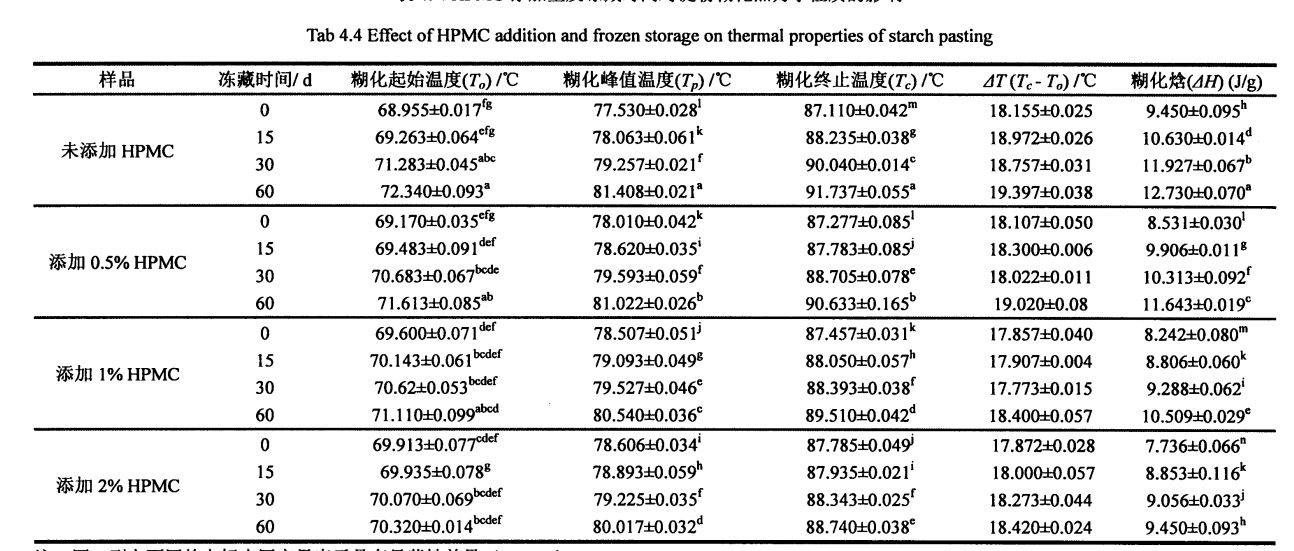
Чӣ тавре ки дар ҷадвали 4.4 нишон дода шудааст, барои амилоидҳои тару тоза, бо афзоиши HPMC илова кардани HPMC LAff фарқияти назаррас надорад, аммо аз 78.010 ± 1.051 2% HPMC), аммо 4,0.0 ± 0.095 (бе иловаи HPMC) ба 8,53 ± 0.030 (илова кардани 1% HPMC) ва 7.066 (илова кардани 2% HPMC). This is similar to Zhou, et a1. (2008), ки илова кардани маҷмӯаи гидрофилӣ, кректаризатсияи крахмалро коҳиш дод ва ҳарорати қуллаи криматизатсияро афзун кард [172]. This is mainly because HPMC has better hydrophilicity and is easier to combine with water than starch. At the same time, due to the large temperature range of the thermally accelerated gelation process of HPMC, the addition of HPMC increases the peak gelatinization temperature of starch, while the gelatinization Enthalpy decreases.
X. x-рентгенси рентгенӣ (XRD) аз ҷониби хиёнати X-и рентгенӣ ба даст оварда мешавад, ки доираи парҳезӣ мебошад, ки ин маълумотро барои гирифтани маълумот, сохтор ё морфологияи атомҳо, сохтор ё морфологияи атомҳо ё молекулаҳо дар мавод таҳлил мекунад. Азбаски гранулҳои крахмал як сохтори маъмулии кристалл доранд, XRD аксар вақт барои муайян кардани шакли кристаллографӣ ва зуҳури хешовандони кристаллҳои крекстал истифода мешавад.
Figure 4.6. As shown in A, the positions of the starch crystallization peaks are located at 170, 180, 190 and 230, respectively, and there is no significant change in the peak positions regardless of whether they are treated by freezing or adding HPMC. Ин нишон медиҳад, ки, ҳамчун амволи олиќиќии кристаллизии крахмал мадад гандум, шакли кристаллӣ устувор боқӣ мемонад.
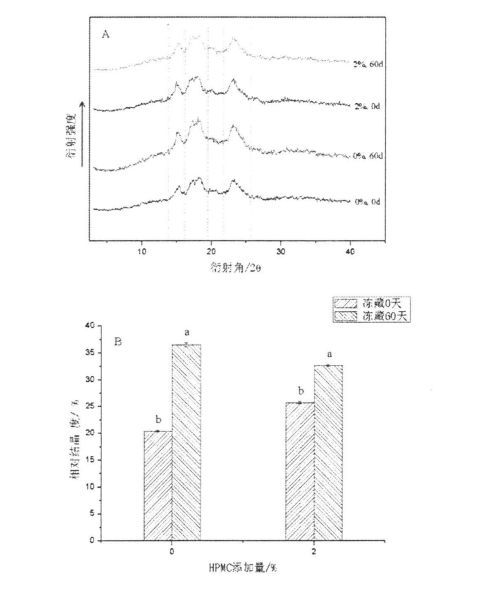
Сардор модари фаровони хушки дар хамир, ки пас аз желататсия хислатҳои нодирро (миқдор, ҳаҷм, матн, ҳассос, мазза, мазза ва ғайра) ба маҳсулоти хамир илова мекунад. Азбаски тағирёбии сохтори тахрарказ ба хусусияти гулпарварии он таъсир мерасонад, хусусиятҳои гелатсионӣ, хусусиятҳои гелатсионӣ, шурӯъ кардани штампҳои крахмалро бо санҷиши таваққуфҳои мухталифи HPMC таҳқиқ карда мешаванд. Тағирот дар хосиятҳои ферологӣ, хосиятҳои терродинамик ва сохтори кристалл барои арзёбии таъсири муҳофизати HPMC илова кардани иловагии сохтори крахмал ва хусусиятҳои марбута истифода мешуданд. Натиҷаҳои таҷрибавӣ нишон доданд, ки пас аз 60 рӯз аз нигоҳубини яхкардашуда, хусусиятҳои ғилдирактикии қавӣ, пайгирии ҳадди ақали (часпак ва арзиши ретбарус) аз ҳад зиёд баланд шудани зуҳуроти нисбии крахмал ва афзоиши қаҳвахонаи крахмал афзоиш ёфтанд. The gelatinization enthalpy increased, while the gel strength of starch paste decreased significantly; Аммо, хусусан боздоштани крахмал бо 2% HPMC, афзоиши ҳуруфи хешовандон ва қуввати гелаксӣ аз он иборат аст, ки тасвири гелматизатсияро аз он иборат аст, ки ин ба илова кардани он сохтори крахмал ва хосиятҳои reelationarize-и он нисбатан пасттар буд.
Хамиртуруши микроорганизмҳои ғайрикушӣ мебошад, сохтори ҳуҷайраи он девори ҳуҷайра, митохондрия ва ғайра, ва навъи ғизоии он микроорганизмҳои анайеробикӣ мебошад. Тибқи шароити аноэробикӣ, он машрубот ва қувва истеҳсол мекунад, дар ҳоле, ки дар шароити авлехникӣ он барои истеҳсоли гази карбон, об ва энергетика метоксиди карбон меоварад.
Зеро HPMC дорои иқтидори қавии об ва нигоҳ доштани об мебошад, ки онро ба системаи хамир илова мекунад, метавонад ташаккул ва афзоиши кристаллҳои яхро манъ кунад. In this experiment, different amounts of HPMC were added to the dough, and after a certain period of time after frozen storage, the quantity of yeast, fermentation activity and glutathione content in unit mass of dough were determined to evaluate the protective effect of HPMC on yeast under freezing conditions.
Истеъсолкунанда
See Meziani, et a1. (2012)'s experimental method [17 cited, with slight modifications. Weigh 5 g of frozen dough into a 50 mL colorimetric tube, press the dough to a uniform height of 1.5 cm at the bottom of the tube, then place it upright in a constant temperature and humidity box, and incubate for 1 h at 30 °C and 85% RH, after taking it out, measure the proofing height of the dough with a millimeter ruler (retain two digits after the decimal point). Барои намунаҳо бо канораҳои болоии нобаробар пас аз супурдани баробар, барои чен кардани баландиҳои мувофиқ (масалан, ҳар як 900) ва арзишҳои баландии ченшуда ба ҳисоби миёна интихоб карда шуданд. Each sample was paralleled three times.
Вазни 1 г хамир, онро ба найчаи санҷишӣ бо 9 мл аз рӯи талаботи амалиёти асъорона илова кунед, онро бо нишондиҳандаи консентратсионӣ ба монанди 101 илова кунед, ва баъд онро ба як қатор грейдерияи консентратсионӣ то 10'1 илова кунед. Draw 1 mL of dilution from each of the above tubes, add it to the center of the 3M yeast rapid count test piece (with strain selectivity), and place the above test piece in a 25°C incubator according to the operating requirements and culture conditions specified by 3M. 5 d, take out after the end of the culture, first observe the colony morphology to determine whether it conforms to the colony characteristics of yeast, and then count and microscopically examine [179]. Each sample was repeated three times.
Баландии аз ҷониби хамир, ки аксар вақт аз натиҷаи маҷмӯии фаъолияти гази аз хаммом ва хамир қувваи шабака мебошад. Дар байни онҳо, фаъолияти аз марги хамиртаъди газ ва истеҳсоли гази газ, ва ҳаҷми истеҳсоли гази хамиртурушест, ки сифати маҳсулоти ордро, аз ҷумла ҳаҷми мушаххас ва матн муайян мекунад. Фаъолияти ферментатсияи хамиртуруш аз омилҳои беруна иборат аст (ба монанди тағирот дар манбаъҳои моддаҳои ғизоӣ, ба мисли манбаъҳои карбон ва нитроген, ҳарорат, ҳарорат, фаъолияти системаҳои метабололии мубодилаи моддаҳои мубодилаи моддаҳои мубодилаи моддаҳои мубодилаи моддаҳои мубодилаи модмаҳои мубодила ва ғайра).

In the case of frozen storage, since the frozen water in the dough system is converted into ice crystals, the osmotic pressure outside the yeast cells is increased, so that the protoplasts and cell structures of the yeast are under a certain degree of stress. Вақте ки ҳарорат дар ҳарорат паст ё нигоҳ дошта мешавад, миқдори ками кристаллҳои ях дар ҳуҷайраҳои хамиртуруш, экспавозатсияи моеъи ҳуҷайра, ба мисли озод шудани моддаҳои хурд - золим ё ҳатто марги моеъ; Ҳамзамон, хамиртуруши таҳти фишори экологӣ, фаъолияти мубодилаи моддии худро коҳиш медиҳад ва баъзе қаламча истеҳсол карда мешавад, ки фаъолияти истеъмоли газро аз хамиртуруши газ коҳиш хоҳад ёфт.
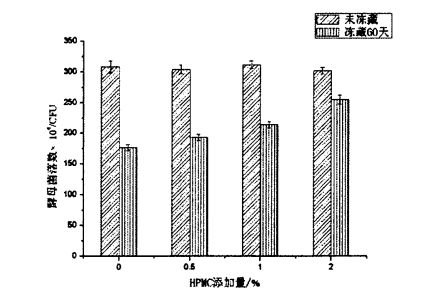
Онро аз ҷадвали 5.2 дида мешавад, ки дар шумораи колонияҳои қадимӣ дар намунаҳои чипта бо мундариҷаи мухталифи HPMC бидуни табобати яхкунӣ вуҷуд надорад. Ин ба он монанд аст, ки дар натиҷае, ки вай аз ҷониби Диапманн, Заннинӣ, & arendt (2015) муайян карда шудааст (2015) [180]. Бо вуҷуди ин, пас аз 60 рӯз кумакҳои намнокӣ, аз 3.08x106 CFU ба 1.76x106 CFM (бе илова кардани HPMC) коҳиш ёфтааст; from 3.04x106 CFU to 193x106 CFU (adding 0.5% HPMC); reduced from 3.12x106 CFU to 2.14x106 CFU (added 1% HPMC); reduced from 3.02x106 CFU to 2.55x106 CFU (added 2% HPMC). By comparison, it can be found that the freezing storage environment stress led to the decrease of the yeast colony number, but with the increase of HPMC addition, the degree of the decrease of the colony number decreased in turn. This indicates that HPMC can better protect yeast under freezing conditions. The mechanism of protection may be the same as that of glycerol, a commonly used strain antifreeze, mainly by inhibiting the formation and growth of ice crystals and reducing the stress of low temperature environment to yeast. Figure 5.3 is the photomicrograph taken from the 3M yeast rapid counting test piece after preparation and microscopic examination, which is in line with the external morphology of yeast.
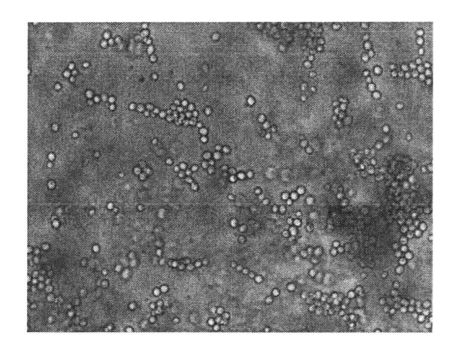
Glutathione is a tripeptide compound composed of glutamic acid, cysteine and glycine, and has two types: reduced and oxidized. When the yeast cell structure is destroyed and died, the permeability of the cells increases, and the intracellular glutathione is released to the outside of the cell, and it is reductive. It is particularly worth noting that reduced glutathione will reduce the disulfide bonds (-SS-) formed by the cross-linking of gluten proteins, breaking them to form free sulfhydryl groups (.SH), which in turn affects the dough network structure. stability and integrity, and ultimately lead to the deterioration of the quality of fermented flour products. Usually, under environmental stress (such as low temperature, high temperature, high osmotic pressure, etc.), yeast will reduce its own metabolic activity and increase its stress resistance, or produce spores at the same time. Вақте ки шароити муҳити зист барои рушд ва такрористеҳсоли он мувофиқ аст, пас мубодилаи моддаҳо ва тарзи паҳншавии паҳнкуниро барқарор мекунад. However, some yeasts with poor stress resistance or strong metabolic activity will still die if they are kept in a frozen storage environment for a long time.
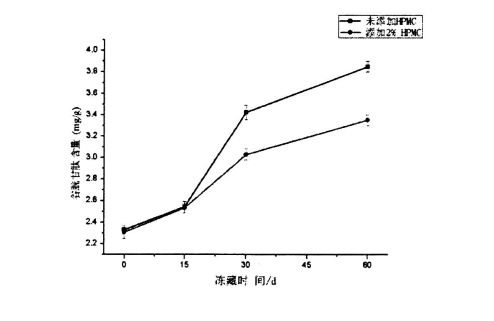
Тасвири 5.4 огозии HPMC Иловагӣ ва анбори яхкардашуда дар мундариҷаи глутатия (Gsh)
As shown in Figure 5.4, the glutathione content increased regardless of whether HPMC was added or not, and there was no significant difference between the different addition amounts. Ин метавонад бошад, зеро баъзе аз хамиртуруши хушкшудаи фаъол барои сохтани хамир, ба муқобилият ва таҳаммулпазирӣ фишори заиф доранд. Under the condition of low temperature freezing, the cells die, and then glutathione is released, which is only related to the characteristics of the yeast itself. It is related to the external environment, but has nothing to do with the amount of HPMC added. Therefore, the content of glutathione increased within 15 days of freezing and there was no significant difference between the two. However, with the further extension of the freezing time, the increase of glutathione content decreased with the increase of HPMC addition, and the glutathione content of the bacterial solution without HPMC was increased from 2.329a: 0.040mg/ g (frozen storage for 0 days) increased to 3.8514-0.051 mg/g (frozen storage for 60 days); while the yeast liquid added 2% HPMC, its glutathione content increased from 2.307+0 .058 mg/g (frozen storage for 0 days) rose to 3.351+0.051 mg/g (frozen storage for 60 days). This further indicated that HPMC could better protect yeast cells and reduce the death of yeast, thereby reducing the content of glutathione released to the outside of the cell. This is mainly because HPMC can reduce the number of ice crystals, thereby effectively reducing the stress of ice crystals to yeast and inhibiting the increase of extracellular release of glutathione.
Хамиртуруш ҷузъи ҷудонопазир ва муҳим дар маҳсулоти ордашидашуда аст ва фаъолияти ферментатсияи он бевосита ба сифати маҳсулоти ниҳоӣ таъсир мерасонад. Дар ин озмоиш, таъсири муҳофизати HPMC дар санги яхдошти яхдошта бо омӯзиши таъсири иловаҳои HPMC-и гуногуни HPMC дар фаъолияти хурди хамиртуруш, рақами пурқуввати глутатикулятӣ дар хамир яхкардашуда арзёбӣ карда шуд. Тавассути таҷрибаҳо, муайян гардид, ки илова кардани HPMC метавонад фаъолияти ферментатсияи хамиртурушро нигоҳ дорад ва сатҳи паст шудани сатҳи коҳиши ҳаҷми муайяншудаи маҳсулоти ниҳоиро коҳиш диҳад; in addition, the addition of HPMC effectively The decrease of yeast survival number was inhibited and the increase rate of reduced glutathione content was reduced, thereby alleviating the damage of glutathione to dough network structure. This suggests that HPMC can protect yeast by inhibiting the formation and growth of ice crystals.
Вақти почта: октябр-08-2022







